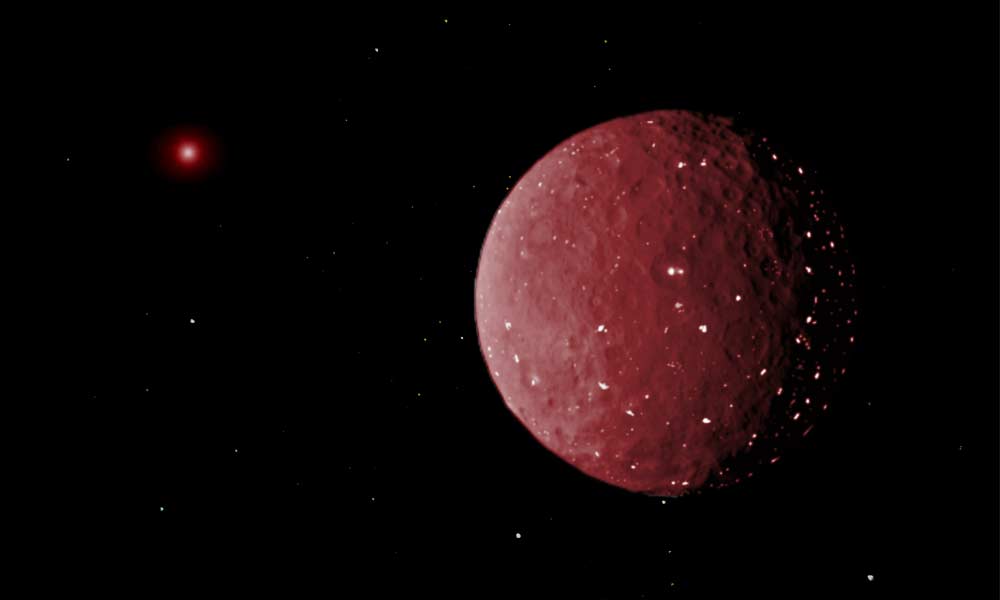
2495 Jamaliya Verschwörung

Eine nukleare 200 Kilotonnen Explosion zerstört Jamaliya, eine Millionenstadt in Dravida Nadu (Südindien). 800.000 Menschen kommen ums Leben, drei Millionen sind verletzt, 15 Millionen werden obdachlos. Das Profil der Explosion deutet auf eine Antimaterie-Reaktion hin. Die offizielle Untersuchung vermutet als Ursache einen illegalen Amat-Reaktor in einem Vorort nahe der Ingenieurshochschule von Tiruvathevan. Die wahren Umstände kommen erst 100 Jahre später ans Licht.
Die Antimaterie-Detonation war tatsächlich auf einen illegalen Reaktor zurückzuführen, aber nicht, wie angenommen, durch einen technischen Fehler, sondern sie war bewusst ausgelöst worden im Rahmen einer Geheimoperation der Koalition auf der Erde. Die Explosion sollte ein anderes Verbrechen zu vertuschen.
Die Operation "Eryu" (=flüstern) wurde durchgeführt vom Koalitionsnachrichtendienst repräsentiert durch Dianfu Fuwu, die Subversionseinheit des Xinyu Xin Duohui, dem auf die Rückgewinnung der Erde spezialisierten Teil des Geheimdienstes von Xinyu Xin, einer lunaren Mega-Souveränität. Dianfu Fuwu experimentierte in Jamaliya mit einem Memvirus. Dafür wurde ein Designervirus freigesetzt, das bei Infektion Meinungen und Überzeugungen verändern kann. Dianfu Fuwu hatte das Virus im lunaren Orbit entwickelt mit dem Ziel, die irdische Öffentlichkeit für expansionistische Propaganda empfänglicher zu machen. Das Virus überwindet die Blut-Hirn-Schranke und manipuliert die neuronale Verarbeitung durch Freisetzung von Hormonen und direkte Aktivierung von Neuronen. Die richtige Auswahl der neuronalen Areale erwies sich als schwierig. Man konnte auf umfangreiche Methoden der viralen Depressionstherapie zurückgreifen, aber die gezielte Manipulation unterbewusster Ideen war eine neue Qualität. Tests während der Entwicklung zeigten eine Erfolgsquote von 30% für eine erfolgreiche Installation einer liberalen, expansionistischen Ideenwelt bei geringen Nebenwirkungen durch Beeinflussung anderer Areale. Das wurde als ausreichend angesehen.
Das Virus sollte sich sehr langsam ohne Krankheitsmerkmale verbreiten, um die Gesundheitskontrolle zu unterlaufen. Man hatte dabei das rituelle Bad im Ambuli River beim Wasserfest übersehen, bei dem sehr viele Viren in das Wasser gelangten und durch die lokale Wasserversorgung schnell die Bevölkerung einiger Stadtteile infizierten. Gleichzeitig tauchte eine Nebenwirkung auf, die bei einem kleinen Teil der Infizierten Hemmungen und Moral ausschaltete. Jamaliya wurde über Nacht von einer unerklärlichen Gewaltwelle heimgesucht. Die Infektion schien sich außerdem wesentlich schneller direkt zu verbreiten, als man in der sterilen Umgebung im Mondorbit angenommen hatte.
Die Verantwortlichen bei Dianfu Fuwu befürchteten, dass die Gesundheitsbehörden der Union sehr schnell die Ursache der Gewaltwelle entdecken würden und dass die Erde drastisch auf diese massive Verletzung ihrer Souveränität reagieren würde. Sie veranlassten deshalb – ohne Rücksprache mit der Koalition – durch einen lokal operierenden Agenten die Fehlfunktion eines der illegalen Amat-Reaktoren. Die Explosion löscht das südliche Jamaliya aus.
Einzelne verschleppte Infektionen stellen keine Gefahr dar, da die von Mensch zu Mensch bei normalem Kontakt übertragene Virenmenge (meistens) zu gering für eine Infektion ist.
Die Jamaliya Verschwörung wird bekannt durch die Veröffentlichung von mehreren tausend Dokumenten der Operation "Eryu" durch einen Insider bei Dianfu Fuwu. Sie ist ein Beleg für den Umfang der Geheimoperationen der Koalition auf der Erde während der Isolation, ein klarer Verstoß gegen die offizielle Politik und die Vereinbarungen von Quadrupol.
2497 Entsendung eines Forschungsschiffes nach Ross 614

Der Flug dauert vier Jahre. Am Ziel wird eine ständige Forschungsstation eingerichtet und Kontakt mit der dortigen Zivilisation aufgenommen.
ADIC ist die Behörde für Entwicklung und interstellare Beziehungen der Koalition. Sie wurde 15 Jahren zuvor gegründet, um die interstellare Entwicklung der Menschheit strukturiert voranzubringen. Als die scheinbare Geschwindigkeit von Überlichtantrieben den Faktor drei erreicht, baut die Behörde ein Interstellarschiff, um ihre Außenabteilung nach Dilan zu transportieren. Kelonikoa Pono, die Leiterin der Außenabteilung wird vom Koalitionsrat mit diplomatischen Vollmachten ausgestattet. Sie ist damit die erste interstellare Botschafterin der Menschheit.
Ross 614 ist ein roter Zwerg, ein sogenannter Flare-Stern. Er hat keine bewohnbaren Planeten. Aber es gibt eine technische Zivilisation auf Dilan, einem Planeten von Vesta-Größe ohne eigene Atmosphäre. Im Solsystem würde Dilan als Zwergplanet oder Asteroid gelten. Bei Ross 614 zieht er allein seine Bahn um die Sonne. Das System hat noch einige andere Zwergplaneten, Planeten der Neptun-Klasse und einen weiteren noch lichtschwächeren roten Zwerg.
Die Zivilisation von Dilan ist sehr fremdartig. Sie ist technisch orientiert. Sonst könnte sie sich auf dem atmosphärenlosen Kleinplaneten nicht behaupten. Der gesamte Asteroid scheint durchdrungen von unzähligen Tunneln und Kammern. Er ist wie ein gigantisches Beehive (Bienenstock)-Habitat. Alle Tunnel werden genutzt. Viele sind mit technischen Anlagen gefüllt. Oft ist der Zweck für Menschen nicht klar. Die meisten Tunnel haben Atmosphäre. Die Bewohner sind überall in großer Zahl.
Die Wesen sind etwa 50 Zentimeter groß und bestehen scheinbar nur aus acht Armen und einem Körper/Kopf Segment in der Mitte. Alle Arme entspringen an einer Seite des Körpers. Die Wesen bewegen sich geschickt mit ihren acht Armen durch die Schwerelosigkeit. Sie sind komplett schwarz und haarlos. Vieles deutet darauf hin, dass die Wesen einst auf einem Sauerstoffplaneten auf ihren acht Armen gelaufen sind und einige davon als Manipulatoren benutzt haben. Inzwischen haben sie sich weitgehend an die Schwerelosigkeit angepasst.
Menschen können sich fast überall frei bewegen. Die Wesen scheinen sich nicht für die neugierigen Menschen zu interessieren. Bei einigen wenigen Versuchen, Geräte zu entfernen, widersetzen sie sich aber energisch. Manche Wege sind wie zufällig durch eine Wand aus Körpern versperrt. Die Barriere löst sich auf, wenn man sich entfernt, entsteht aber schnell wieder, sobald man näherkommt. Bisher gab es von Menschen keine Versuche Gewalt anzuwenden. Obwohl nur ein kleiner Teil von Dilan erkundet wurde, schätzt man, dass Dilan mehr als 100 Milliarden Individuen beherbergt. Damit wollte man sich lieber nicht anlegen.
Die Zivilisation wirkt sehr statisch. Es gibt Hinweise darauf, dass sie mehr als 50.000 Jahre alt ist. Die Menschen scheinen nicht die ersten Besucher zu sein. Sicher wissen sich diese Wesen auch gegen größere Störungen zu wehren, sonst wären sie nicht schon so lang da. Der Technologielevel ist höher als im Solsystem. Es gibt Anzeichen, dass die Dilan-Zivilisation menschliche Technologie als primitiv betrachtet. Da der ganze Kleinplanet durchtunnelt ist, steht der Dilan-Zivilisation ein gewaltiges nutzbares Volumen zur Verfügung. Welche technischen Ressourcen die Dilan-Wesen wirklich haben, ist nicht abzuschätzen. Die Menschen möchten aber sicher nicht riskieren, es auf unfreundliche Art herauszufinden.
Es ist nicht klar, wie die Zivilisation organisiert ist, ob es Unterorganisationen wie Staaten gibt oder ob alles ein Superstaat ist. Die anonymen Massen von Dilan-Wesen wirken wie ein Ameisenstaat. Aber es gibt keine Anzeichen für eine Königin oder eine herrschende Klasse. Auch die Art der Fortpflanzung ist unbekannt. Junge Dilan-Wesen oder andere Formen wurden nicht entdeckt. Überall sind die gleichen schwarzen 8-armigen Gestalten, die ihren Tätigkeiten nachgehen.
Es gibt nur geringen Flugverkehr im System, vor allem zu den großen Planeten. Man vermutet zur Gasgewinnung. Dilan ist weitgehend autark. Die Zivilisation scheint alles wiederzuverwenden. Trotzdem sind sie an einigen zusätzlichen Rohstoffen interessiert.
Die Beziehungen sind neutral und distanziert. Es gibt so etwas wie Handelsaustausch. Die Forschungsmission hat eine Auswahl von seltenen Erden und Edelmetallen an Bord. Nach einiger Zeit kann man den Wesen von Dilan deutlich machen, dass man gerne einen kleinen Container mit Rohstoffen gegen technische Geräte tauschen würde. Es gelingt den Menschen sogar zu bestimmen, gegen welche technischen Geräte die Rohstoffe getauscht werden sollen. So entsteht ein einfacher Warenaustausch. Allerdings gibt es nicht viel Kommunikation darüber hinaus. Man kommuniziert mit ständig wechselnden Wesen. Fragen nach den anderen Individuen werden anscheinend nicht verstanden. Die Wesen sind zweifelsfrei intelligent, aber es scheint kein Konzept für Individualität zu geben.
Das Schiff der ADIC bleibt drei Monate und fliegt dann zurück. Nach insgesamt neun Jahren erreicht die Expedition wieder unser Sonnensystem.
Ein Jahr später wird eine zweite Mission ausgesandt, um eine ständige Forschungsstation auf Dilan zu errichten. Das Schiff wird so umgerüstet, dass es genügend Material für einen längeren Aufenthalt transportieren kann. Dafür wird die Fähigkeit zum Rückflug aufgegeben. Nach der Ankunft soll das Schiff als dauerhafte Forschungsstation dienen und auf weitere Versorgungsflüge warten.
Kelonikoa Pono und ihre Crew erreichen Dilan nach weiteren vier Jahren Flugzeit und errichten eine ständige Basis auf der Oberfläche von Dilan in der Nähe eines großen Eingangstunnels.
Mehr Katastrophen
2199 Anschlag auf das Dubai-Kosmodrom
2248 Gemini-Katastrophe
2375 Bruch einer Raumstation
2495 Jamaliya Verschwörung
2532 Panik im Sonnensystem
2535 Tragödie von Cobol
2557 Invasion aus dem Orbit
2711 Fox-Katastrophe
2721 Spacedom-Tragödie
2851 Katastrophaler Zusammenstoß
3190 Überraschungsangriff
3361 Erste Menschheit
Neue Beiträge
2158 Space Patrol
2222 Weltraumpiraten
2326 Kein interplanetarer Krieg
3050 Königliche Garde
3090 Solo Ehre
2234 Am Ende des Orbits
2248 Gemini-Katastrophe
2366 Orbitale Ökonomie
2312 Kaio-Artefakt
3361 Erste Menschheit
2333 Metrische Impulsverstärkung
2337 Verschwörung im Orbit
2247 Quantensprung
2284 Trennung der Erde
2321 Isolation der Erde
2205 Unternehmensnationen
2192 Antiexpansionistischer Terror
2179 Private Asteroidenbasis
2231 Vereinte Planeten
2291 Verbotene Forschung
Die Besten
(20 von 75)
2265 Öko-Militarismus
2326 Kein interplanetarer Krieg
2412 Pontos Mission
2469 500 Jahre Tranquility
2478 Razzia im Asteroidengürtel
2493 Oumuamua
2560 Fakultät für Exotechnologie
2630 Verschwörung gegen die Menschheit
2668 Ultrametalle
2681 Roboterzivilisation
2720 Spacedom-Tragödie
2722 Sein Leben für die Kinder
2806 Weltraum Müll
2915 Belagerungskanone
2956 Chaosmanager
3050 Königliche Garde
3090 Solo Ehre
3190 Überraschungsangriff
3353 Tor der Kontroverse
3361 Erste Menschheit
 2493
Oumuamua
2493
Oumuamua

 2501
Extraplanetare Forschung
2501
Extraplanetare Forschung